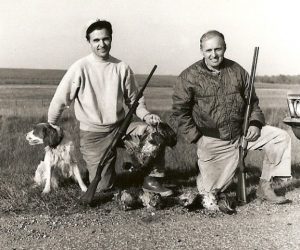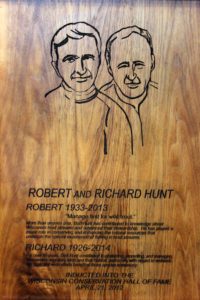1926 – 2014
Inducted 2012
“For over 60 years, he contributed to protecting, promoting and managing Wisconsin’s migratory birds and their habitat, particularly with regards to wetlands.” — from Hunt’s Hall of Fame biography
 Dick Hunt was born in 1926; Bob Hunt (WCHF Inductee) in 1933. They grew up in the small town of McFarland on Lake Waubesa, near Madison. The lake, river and associated wetlands, together with their interest in hunting and fishing oriented the Hunt brothers towards their professional careers in wildlife and fisheries management. Both had military experience, both received college degrees at the UW-Madison where they were strongly influenced by the successors of Aldo Leopold. Dick zeroed in on the management of upland game and waterfowl while Bob’s zeal was for trout management. Together they performed 69 years of extraordinarily productive work with the Wisconsin Conservation Department and its successor the Department of Natural Resources.
Dick Hunt was born in 1926; Bob Hunt (WCHF Inductee) in 1933. They grew up in the small town of McFarland on Lake Waubesa, near Madison. The lake, river and associated wetlands, together with their interest in hunting and fishing oriented the Hunt brothers towards their professional careers in wildlife and fisheries management. Both had military experience, both received college degrees at the UW-Madison where they were strongly influenced by the successors of Aldo Leopold. Dick zeroed in on the management of upland game and waterfowl while Bob’s zeal was for trout management. Together they performed 69 years of extraordinarily productive work with the Wisconsin Conservation Department and its successor the Department of Natural Resources.
Wisconsin native Richard A. “Dick” Hunt’s career at Horicon Marsh and across the state was marked by solid research that led to sound policies. He was far-sighted, candid and straight-forward, rigorous in his approach to life and career and blessed with a good sense of humor.
After serving with the U.S. Navy in World War II, he earned bachelor’s and master’s degrees at UW-Madison, studying under the likes of Conservation Hall of Fame inductees Joseph Hickey and Robert McCabe.
 He joined the Wisconsin Conservation Department in 1952. Like his brother, Bob, a fisheries biologist, and a fellow Conservation Hall inductee, he left a major imprint on Wisconsin’s natural resources and the management of wildlife species.
He joined the Wisconsin Conservation Department in 1952. Like his brother, Bob, a fisheries biologist, and a fellow Conservation Hall inductee, he left a major imprint on Wisconsin’s natural resources and the management of wildlife species.
Dick Hunt played a key role in efforts to sensitize wildlife managers and sportsmen to the dangers of lead poisoning of waterfowl, especially Canada geese and tundra swans. He collected hundreds of dead and dying geese that were analyzed at the Wisconsin Department of Agriculture’s Animal Diagnostic Laboratory. As a result of his work, Wisconsin was one of the first states to switch to non-toxic shot. At a time when an expensive captive-reared mallard release program was being considered, his research proved that it wouldn’t do much to boost the state’s duck population. The idea was abandoned.
Hunt was also involved in efforts to rear or capture free flying Canada geese and transplant them to restore the species, helping to boost Wisconsin’s Canada geese population. Representing Wisconsin on the Mississippi Flyway Council’s Technical Section, he was able to share expertise and influence waterfowl research and management beyond the state’s boundaries. He was also able to assure sufficient goose quotas for Wisconsin, emphasizing that geese around Horicon were causing unacceptable crop damage.
Working with Conservation Hall of Fame inductee Laurence Jahn, he co-authored an influential bulletin, “Duck and Coot Ecology and Management in Wisconsin,” then one of the most comprehensive assessments of a breed ground state’s waterfowl and wetland resources. It remains an important historical reference today.
Promoted to Wetland Group Leader in 1960, Hunt supervised biologists and technicians studying subjects ranging from ducks and geese to woodcock. They studied nesting cover, controlling cattails and use of managed hunts to achieve biological targets. He frequently cooperated with universities on joint research projects and, upon retiring in 1987, served as a lecturer on waterfowl management at UW-Stevens Point.
Resources
One Family – Two Unique Conservationists, article by Susan Bence for WUWM News, 2012
Lead Poisoning Wastes Waterfowl, article by Richard Hunt for Wisconsin Conservation Bulletin
